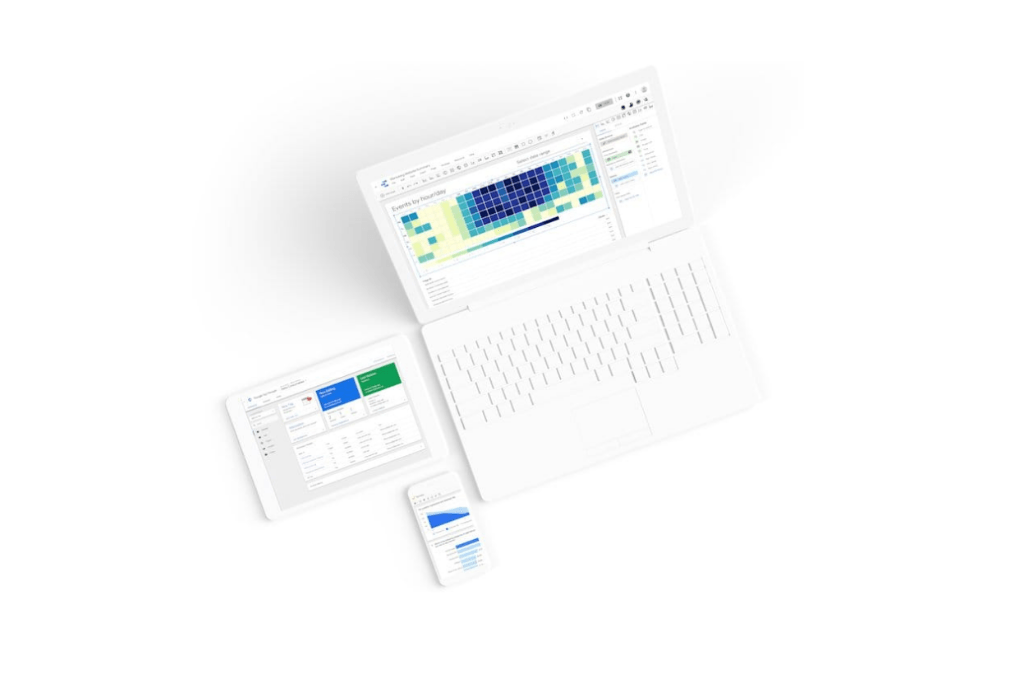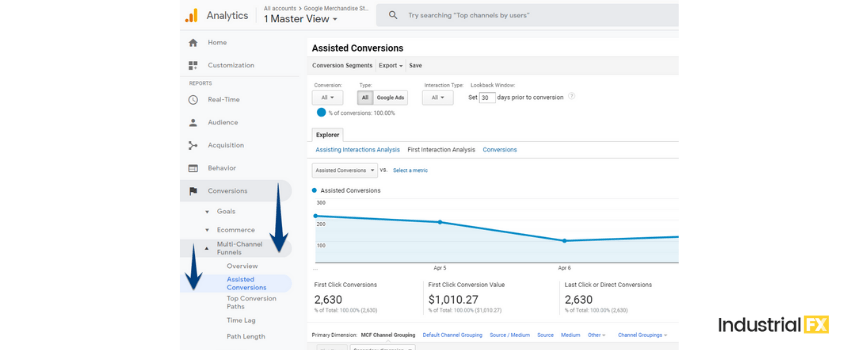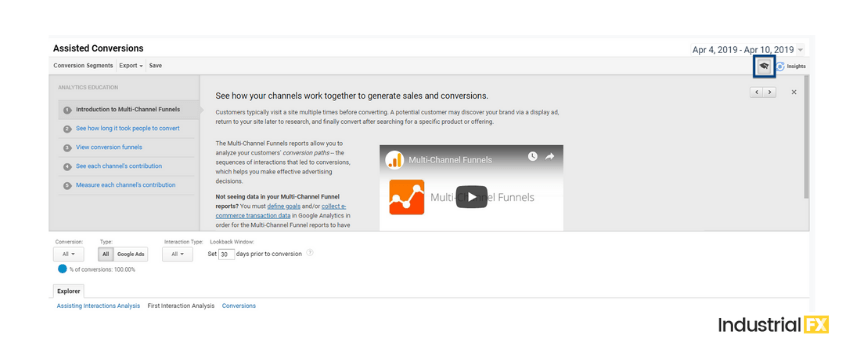Assisted Conversions in Google Analytics: A Must-Read Guide

When it comes to digital marketing, Google Analytics is critical. It’s a powerful platform that provides unmatched insight into your site’s performance, audience, and results. With all the features available in Google Analytics, however, many businesses don’t take full advantage of them.
Assisted conversions in Google Analytics are one example of a tremendously useful feature.
What are assisted conversions though, and how do they help your company’s online marketing strategy? This blog post answers both these questions, plus shows you how to access and view assisted conversions. Keep reading to get started with assisted conversions now!
What is an assisted conversion in Google Analytics?
An assisted conversion describes the number of conversions an online channel helped secure. A channel can earn an assisted conversion by playing one of three roles in the conversion path: last interaction, assist interaction, or first interaction.

A breakdown of these three interactions include:
- Last interaction describes an interaction right before the conversion.
- Assist interaction highlights any interaction on the conversion path, except for the last one.
- First interaction covers the first interaction on the conversion path.
For reference, a conversion can serve as a variety of actions, like a user completing a contact form, purchasing a product, or signing up for an email newsletter. You can define conversions in Google Analytics by creating custom goals.
3 reasons why assisted conversions in Google Analytics matter
In some cases, you may already know why assisted conversions in Google Analytics matter. It’s vital, however, that you and your team recognize the importance of assisted conversions and why measuring them (and the performance of your channels) is critical.
That’s why we’ve outlined the top three reasons why assisted conversions in Google Analytics matter:
1. UNDERSTAND NON-LINEAR BUYER JOURNEYS
Before the Internet became the standard for researching products, services, and companies, consumers and business buyers took a predictable, linear journey to conversion. That’s not the case anymore. People take non-linear paths to purchase, which can make assessing your marketing channels chaotic.
Assisted conversions can help bring stability back to your analytics.

Instead of crediting most of your online sales to pay-per-click (PPC) advertising, for example, you can see that your search engine optimization (SEO) strategy is playing a significant role in driving those buyers to your website.
This knowledge can shift your digital marketing strategy.
For example, you may dedicate more of your budget to optimizing and adding content to your website. Or, you may analyze which pages drive the most qualified traffic, and then look for opportunities to expand their influence or role in the buying journey.
2. GET ACCURATE INSIGHTS INTO YOUR CAMPAIGNS
In online marketing, data is critical. Without it, it’s difficult to make educated decisions about your strategies and campaigns. Instead, you have to guess when it comes to your next move or improvement. This is especially true when it comes to managing a campaign without the help of assisted conversions.
When you reference assisted conversions in Google Analytics, however, your team can make decisions based on data. You can look at the performance of each channel, and then decide how you want to change your strategy or modify your budget.
Even better, your team can support your decisions with data. If a company decision maker questions a move, you can provide the data. Without assisted conversion data, however, your team would rely on inaccurate information that only showed part of the picture when it came to your marketing strategy.
3. MEASURE THE TRUE VALUE OF EVERY CHANNEL
Assisted conversions in Google Analytics also help your business measure the real value of every marketing channel. Whether you’re investing in search engine optimization (SEO) or paid advertising, you can see the actual performance of each one with Google Analytics.
Again, when you understand how each channel performs and helps your company achieve its goals, you can make educated, data-based decisions about your strategy. Businesses can’t underestimate this advantage because it can have a direct impact on your return on investment (ROI).
When you see the value of each channel, you can make the most of your budget. You may redirect funds into extremely cost-effective channels like search, for example, or revise strategies for underperforming channels with potential.
No matter your digital marketing approach, your company needs to view its assisted conversion data.
How to view assisted conversions in Google Analytics
Ok, so how can your team access your assisted conversions in Google Analytics? Just follow these steps:
- Login to your Google Analytics account
- Click “Conversions” on the sidebar menu
- Select “Multi-Channel Funnels”
- Choose “Assisted Conversions”

Once your assisted conversion data generates, you’ll see a few critical columns, including:
- MCF Channel Grouping: Summarizes your assisted conversion channels
- Assisted Conversions: Details the number of assisted conversions earned by each channel
- Assisted Conversion Value: Highlights the financial value of each channel’s assisted conversions
- Last Click or Direct Conversions: Shows the number of final conversion interactions
- Last Click or Direct Conversion Value: Lists the value of each channel’s direct conversions
- Assisted / Last Click or Direct Conversions: Scales channel roles in direct or assisted conversions
Your team can get more from your data by viewing assisted conversion data in a few different ways.
3 tips for viewing assisted conversions in Google Analytics
When you open your assisted conversions in Google Analytics, it’s helpful for your team to view and evaluate the data in a few different ways. That way, you can make an accurate assessment of your strategies and develop smart recommendations for the future.
Three tips for viewing assisted conversions in Google Analytics include:
1. Set your date range
In most cases, your team will want to assess your performance within a specific date range.
You may want to view the performance of your channels for the month, for example. Or, you may want to assess your strategy’s annual results. With a date filter, your team can check the performance of your campaign in a specific timeframe fast, which makes generating reports easy.
2. Filter your data by goals
If you have multiple goals, you can also filter assisted conversions in Google Analytics by goal or objective. This feature is useful when you’re looking to grade the performance of different strategies on specific goals, like sales versus leads.
Depending on your goals, your team may see a significant difference in the performance of channels. For example, your email subscriber efforts may benefit from search and social media, while your sales goals may get the best results (and most assists) from paid and referral traffic.
3. Use your Google Analytics Education resource
Your team can also take advantage of Google’s Analytics Education feature in Google Analytics.

Click the graduation cap in the upper right corner (below your date range filter) to open the Analytics Education menu. It’ll automatically open educational content related to assisted conversions. Your team can view articles, videos, and more — all from within Google Analytics.
This feature can help troubleshoot issues, answer questions, and more.
Increase your assisted conversions with a custom digital marketing campaign
If you’re serious about digital marketing, it’s essential for your team to use assisted conversions in Google Analytics. With assisted conversions, your business can get tremendous insight into the performance of your channels, as well as strategy.
That results in a stronger campaign and better results.
Need help improving your conversions and assisted conversions? IndustrialFX is a trusted choice for manufacturing and industrial businesses. Our decades of experience, plus impressive client results, provide your team with services you can trust.
Contact us online to learn how our award-winning team can help your company grow.
